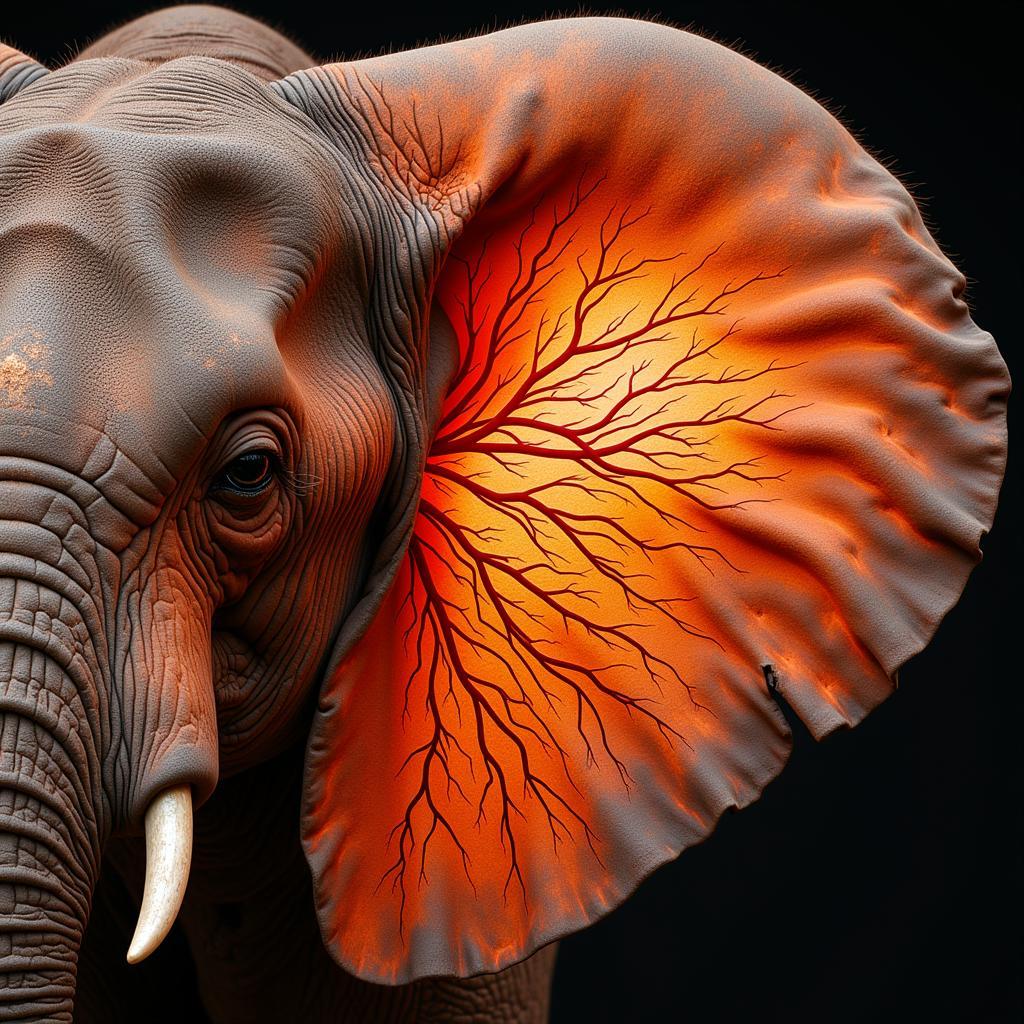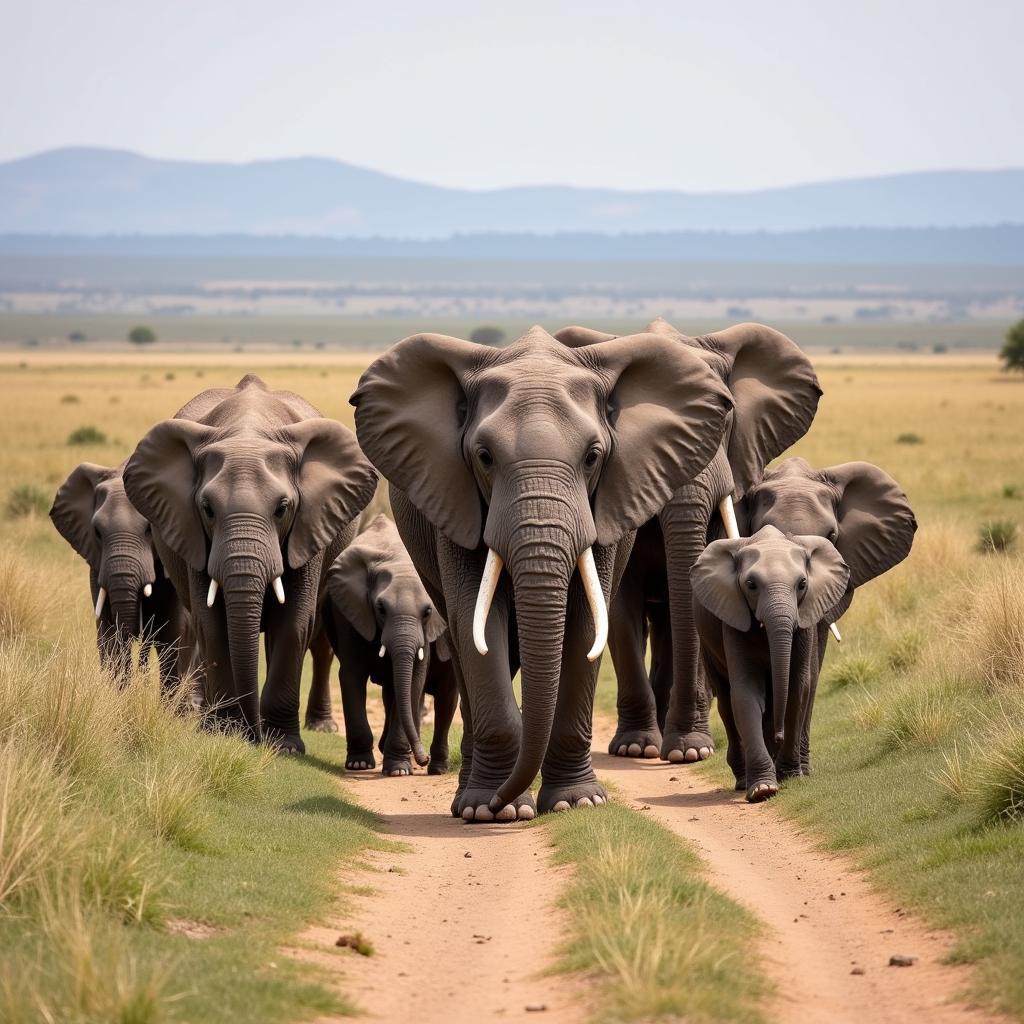Discovering the Majestic African Bush Elephant Features
The African bush elephant, scientifically known as Loxodonta africana, boasts a range of remarkable features that set it apart in the animal kingdom. From its immense size and distinctive ears to its complex social structure and crucial role in the ecosystem, these African Bush Elephant Features are a testament to the wonders of nature. Let’s delve into the details of what makes this creature so iconic.
Compared to the African forest elephant, the bush elephant, also known as the African savanna elephant, is the larger of the two subspecies. They thrive in diverse habitats across sub-Saharan Africa. Want to learn more about the differences between these two incredible creatures? Check out this comparison: African adult bush elephant vs Indian audlt elephant.
Iconic Physical Features of the African Bush Elephant
The African bush elephant’s sheer size is its most striking feature. Adult males can reach heights of up to 4 meters at the shoulder and weigh over 6 tons. Their enormous bodies are covered in thick, gray skin, offering protection from the harsh African sun and insect bites.
The Magnificent Tusks
Both male and female African bush elephants possess tusks, elongated incisor teeth that grow continuously throughout their lives. These ivory tusks serve multiple purposes, from digging for water and minerals to stripping bark from trees and defending against predators. Sadly, these magnificent tusks have also made them targets for poachers, driving the illegal ivory trade.
The Distinctive Ears: A Key Feature
One of the most recognizable African bush elephant features is its enormous ears. Shaped like the continent of Africa itself, these ears play a vital role in thermoregulation. The extensive network of blood vessels within the ears helps dissipate heat, allowing the elephants to maintain a stable body temperature in the scorching African savanna. Flapping their ears creates airflow, further enhancing cooling.
 African Bush Elephant Ears: A Cooling Mechanism
African Bush Elephant Ears: A Cooling Mechanism
The Social Life of the African Bush Elephant
African bush elephants are highly social animals, living in complex matriarchal herds led by the oldest and most experienced female, known as the matriarch. These herds can range in size from a few individuals to several dozen, fostering strong bonds between family members.
Family Ties and Communication
Communication is key to the success of these social structures. Elephants communicate through a variety of vocalizations, including rumbles, trumpets, and roars, which can travel for miles across the savanna. They also use infrasound, low-frequency sounds inaudible to humans, to communicate over long distances.
Raising the Next Generation
Young calves are raised collectively within the herd, with all females contributing to their care. This communal approach ensures the survival of the young and strengthens the bonds within the herd. This nurturing environment is essential for their development. Learn more about the intriguing skeletal structure of these gentle giants: African elephant skeleton.
 African Bush Elephant Herd: Matriarchal Society
African Bush Elephant Herd: Matriarchal Society
The African Bush Elephant’s Role in the Ecosystem
African bush elephants are keystone species, playing a crucial role in shaping their environment. Their foraging habits, such as uprooting trees and digging for water, create habitats for other animals and influence the distribution of vegetation. They are essential for maintaining the balance of the African savanna. Want to explore another fascinating African animal? Discover the elusive African forest cat.
Impact on Vegetation and Water Sources
By clearing dense vegetation, elephants create open grasslands that benefit grazing animals. Their digging activities also create waterholes, providing a vital source of water for other wildlife during dry periods. Their impact on the landscape is profound and far-reaching. Consider the African bush elephant itself: African bus elephant.
Conclusion: Appreciating the African Bush Elephant
The African bush elephant, with its remarkable features and vital role in the ecosystem, is a true icon of the African savanna. Understanding and protecting these magnificent creatures is essential for preserving the biodiversity of our planet. Let’s continue to learn about and appreciate these gentle giants, ensuring their survival for generations to come. It’s crucial to continue supporting conservation efforts to safeguard these majestic animals.
 African Bush Elephant Calf and Mother: Bond and Protection
African Bush Elephant Calf and Mother: Bond and Protection
FAQ
-
What is the lifespan of an African bush elephant?
- They typically live for 60-70 years in the wild.
-
How much do African bush elephants eat in a day?
- An adult can consume up to 300 pounds of vegetation daily.
-
What are the main threats to African bush elephants?
- Poaching for ivory and habitat loss are the most significant threats.
-
How do African bush elephants communicate?
- They use a range of vocalizations, including rumbles, trumpets, and infrasound.
-
What is the social structure of African bush elephants?
- They live in matriarchal herds led by the oldest female.
Common Scenarios and Questions:
-
Scenario: Witnessing an elephant charge.
- Question: What should I do if an elephant charges?
-
Scenario: Hearing elephant rumbles in the distance.
- Question: What do different elephant vocalizations mean?
-
Scenario: Observing an elephant herd interacting.
- Question: How do elephant families function within the herd?
Further Exploration:
Check out our articles on African Cup of Nations 2024 for a glimpse into the vibrant culture of Africa.
Contact Us
When you need assistance, feel free to contact us by Phone: +255768904061, Email: [email protected], or visit us at Mbarali DC Mawindi, Kangaga, Tanzania. Our customer service team is available 24/7.

